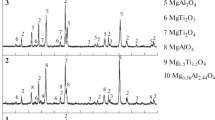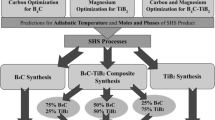Ceramic composite materials based on stabilized zirconium oxide with up to 9 mol.% of the stabilizing additive Y2O3 were obtained in this work by self-propagating high-temperature synthesis. The effect of the stabilizing additive content on the combustion characteristics of the obtained materials and their phase composition was studied. Introduction of Y2O3 into the studied materials was shown to lead to the formation of the cubic modification of ZrO2 in the synthesis products, while three ZrO2 modifications were observed without introduction of Y2O3 into the synthesis products.



Similar content being viewed by others
References
H. Wang, Y. Li, and T. Zhu, “Strengthening of Al2O3-C slide gate plate refractories with microcrystalline graphite,” Ceram. Int., 43(13), 9912 – 9918 (2017); DOI: https://doi.org/10.1016/j.ceramint.2017.04.178.
J. Ban, C. Zhou, L. Feng, et al., “Preparation and application of ZrB2-SiCw composite powder for corrosion resistance improvement in Al2O3–ZrO2–C slide plate materials,” Ceram. Int., 46(7), 9817 – 9825 (2020); DOI: https://doi.org/10.1016/j.ceramint.2019.12.255.
Q. Gu, T. Ma, F. Zhao, et al., “Enhancement of the thermal shock resistance of MgO–C slide plate materials with the addition of nano-ZrO2 modified magnesia aggregates,” J. Alloys Compd., 847, Art. 156339 (2020); DOI: https://doi.org/10.1016/j.jallcom.2020.156339.
K. Matsui, H. Yoshida, and Y. Ikuhara, “Review: Microstructure development mechanism during sintering in polycrystalline zirconia,” Int. Mater. Rev., No. 63, 1 – 32 (2017); DOI: https://doi.org/10.1080/09506608.2017.1402424.
G. Chen, Y. Ling, Q. Li, et al., “Stability properties and structural characteristics of CaO-partially stabilized zirconia ceramics synthesized from fused ZrO2 by microwave sintering,” Ceram. Int., 46(10), 16842 – 16848 (2020); DOI: https://doi.org/10.1016/j.ceramint.2020.03.261.
Q. Chen, T. Zhu, Y. Li, et al., “Enhanced performance of low-carbon MgO–C refractories with nano-sized ZrO2–Al2O3 composite powder,” Ceram. Int., 47(14), 20178 – 20186 (2021); DOI: https://doi.org/10.1016/j.ceramint.2021.04.024.
N. Lu, G. He, Z. Yang, et al., “Fabrication and reaction mechanism of MgO-stabilized ZrO2 powders by combustion synthesis,” Ceram. Int., 48(5), 7261 – 7264 (2021); DOI: https://doi.org/10.1016/j.ceramint.2021.11.286.
M. Vojtko, V. Puchy, E. Mudra, et al., “Coarse-grain CeO2 doped ZrO2 ceramic prepared by spark plasma sintering,” J. Eur. Ceram. Soc., 40(14), 4844 – 4852 (2020); DOI: https://doi.org/10.1016/j.jeurceramsoc.2020.05.014.
Sh. Zhai, J. Liu, D. Lan, et al., “High temperature tensile strength of large size Al2O3/ZrO2(Y2O3) directionally solidified eutectic ceramics,” Mater. Lett., 307, 130950 (2022); DOI: https://doi.org/10.1016/j.matlet.2021.130950.
D. Kunying, Ch. Taotao, and H. Zhiyong, “Formation and properties of porous ZrO2 – 8 wt.% Y2O3 coatings,” Rare Met. Mater. Eng., 47(6), 1677 – 1681 (2018); DOI: https://doi.org/10.1016/S1875-5372(18)30149-8.
Y. Tan, Sh. Gao, Ch. Xiong, et al., “Nano-structured LSM-YSZ refined with PdO/ZrO2 oxygen electrode for intermediate temperature reversible solid oxide cells,” Int. J. Hydrogen Energy, 45(38), 19823 – 19830 (2020); DOI: https://doi.org/10.1016/j.ijhydene.2020.05.116.
F. Marais, I. Sigalas, and D. Whitefield, “The effects of the addition of tetragonal-ZrO2 on the mechanical properties of MgAl2O4–ZrO2 composites,” Ceram. Int., 48(1), 563 – 568 (2022); DOI: https://doi.org/10.1016/j.ceramint.2021.09.134.
S. Aati, Z. Akram, H. Ngo, et al., “Development of 3D printed resin reinforced with modified ZrO2 nanoparticles for long-term provisional dental restorations,” Dent. Mater., 37(6), e360 – e374 (2021); DOI: https://doi.org/10.1016/j.dental.2021.02.010.
B. Sathyaseelan, E. Manikandan, I. Baskaran, et al., “Studies on structural and optical properties of ZrO2 nanopowder for opto-electronic applications,” J. Alloys Compd., 694, 556 – 559 (2017); DOI: https://doi.org/10.1016/j.jallcom.2016.10.002.
T. Norfauzi, A. Hadzley, U. Azlan, et al., “Fabrication and machining performance of ceramic cutting tool based on the Al2O3–ZrO2–Cr2O3 compositions,” J. Mater. Res. Technol., 8(6), 5114 – 5123 (2019); DOI: https://doi.org/10.1016/j.jmrt.2019.08.034.
J. Gao, W. Su, X. Song, et al., “Post-mortem analysis of Cr2O3–Al2O3–ZrO2 refractory bricks used in an industrial opposed multi-burner gasifier,” Eng. Failure Anal., 134, 106017 (2022); DOI: https://doi.org/10.1016/j.engfailanal.2021.106017.
Sh. Wang, W. Zhao, Y. Zhang, et al., “Interactions of Cr2O3–Al2O3–ZrO2 refractory with slags in an entrained-flow coal-water slurry gasifier,” Ceram. Int., 48(1), 1197 – 1207 (2022); DOI: https://doi.org/10.1016/j.ceramint.2021.09.205.
W. Wang, L. Xue, T. Zhang, et al., “The influence of MgO/ZrO2/Al2O3 refractories on the refining process of Ti-containing steel based on kinetic study,” Ceram. Int., 46(11), Part A, 17561 – 17568 (2020); DOI: https://doi.org/10.1016/j.ceramint.2020.04.055.
W. Wang, L. Xue, T. Zhang, et al., “Thermodynamic corrosion behavior of Al2O3, ZrO2 and MgO refractories in contact with high basicity refining slag,” Ceram. Int., 45(16), 20664 – 20673 (2019); DOI: https://doi.org/10.1016/j.ceramint.2019.07.049.
C. Baudin and P. Pena, “The main role of the ZrO2–MgO–CaO and ZrO–MgO–CaO–SiO systems in the field of refractories,” Bol. Soc. Esp. Ceram. Vidrio, 61, Suppl. 1, S6 – S18 (2021); DOI: https://doi.org/10.1016/j.bsecv.2021.09.009.
Z. Wang, K. Su, J. Gao, et al., “Preparation, microstructure and properties of Al2O3–ZrO2–C slide plate material in presence of nanoscale oxides,” Ceram. Int., 48(7), 10126 – 10135 (2021); DOI: https://doi.org/10.1016/j.ceramint.2021.12.223.
A. Keyvani, M. Bahamirian, and B. Esmaeili, “Sol-gel synthesis and characterization of ZrO2 – 25 wt.% CeO2 – 2.5wt.% Y2O3 (CYSZ) nanoparticles,” Ceram. Int., 46(13), 21284 – 21291 (2020); DOI: https://doi.org/10.1016/j.ceramint.2020.05.219.
Y. J. Xia, J. L. Song, D. N. Yuan, et al., “Synthesis and characterization of one-dimensional metal oxides: TiO2, CeO2, Y2O3-stabilized ZrO2 and SrTiO3,” Ceram. Int., 41(1), Part A, 533 – 545 (2015); DOI: https://doi.org/10.1016/j.ceramint.2014.08.102.
W. S. Lee, S. W. Kim, B. H. Koo, et al., “Synthesis and microstructure of Y2O3-doped ZrO2–CeO2 composite nanoparticles by hydrothermal process,” Colloids Surf., A, 313/314, 100 – 104 (2008); DOI: https://doi.org/10.1016/j.colsurfa.2007.04.079.
I. V. Kozerozhets, G. P. Panasyuk, E. A. Semenov, et al., “New approach to prepare the highly pure ceramic precursor for the sapphire synthesis,” Ceram. Int., 46(18), Part A, 28961 – 28968 (2020); DOI: https://doi.org/10.1016/j.ceramint.2020.08.067.
P. M. Bazhin, E. V. Kostitsyna, A. P. Chizhikov, et al., “Synthesis and structure peculiarities of composite material based on Al2O3–ZrO2 hardened with W and WB particles,” J. Alloys Compd., 856, 157576 (2021); DOI: https://doi.org/10.1016/j.jallcom.2020.157576.
A. M. Stolin, P. M. Bazhin, A. S. Konstantinov, et al., “Synthesis and characterization of Al2O3–ZrO2-based eutectic ceramic powder material dispersion-hardened with ZrB2 and WB particles prepared by SHS,” Ceram. Int., 44(12), 13815 – 13819 (2018); DOI: https://doi.org/10.1016/j.ceramint.2018.04.225.
A. Bazhina, A. Chizhikov, A. Konstantinov, et al., “Structure, phase composition and mechanical characteristics of layered composite materials based on TiB/xTi-Al/α-Ti (x = 1, 1.5, 3) obtained by combustion and high-temperature shear deformation,” Mater. Sci. Eng., 858, Art. 144161 (2022); DOI: https://doi.org/10.1016/j.msea.2022.144161.
A. D. Bazhina, A. S. Konstantinov, A. P. Chizhikov, et al., “Materials based on the MAX phases of the Ti-Al–C system obtained under combustion and high-temperature shear deformation,” Mater. Lett., 318, Art. 132196 (2022); DOI: https://doi.org/10.1016/j.matlet.2022.132196.
A. P. Chizhikov and A. S. Konstantinov, “Production of ceramic plates based on Al2O3–TiB2 by free SHS compression,” Refract. Ind. Ceram., 62(1), 94 – 97 (2021); DOI: https://doi.org/10.1007/s11148-021-00565-w.
I. V. Kozerozhets, G. P. Panasyuk, L. A. Azarova, et al., “Acquisition, properties, and application of nanosized magnesium oxide powders: An overview,” Theor. Found. Chem. Eng., 55, 1126 – 1132 (2021).
A. Bazhina, A. Konstantinov, A. Chizhikov, et al., “Structure and mechanical characteristics of a layered composite material based on TiB/TiAl/Ti,” Ceram. Int., 48(10), 14295 – 14300 (2022); DOI: https://doi.org/10.1016/j.ceramint.2022.01.318.
A. I. B. Rondao, E. N. S. Muccillo, R. Muccillo, et al., “On the electrochemical properties of Mg-PSZ: An overview,” J. Appl. Electrochem., 47, 1091 – 1113 (2017); DOI: https://doi.org/10.1007/s10800-017-1112-z.
S. Ahmed, B. Li, and L. Zou, “Sintering of free-standing zirconia granules with different Y2O3 concentration,” Adv. Appl. Ceram., 119, 407 – 413 (2020); DOI: https://doi.org/10.1080/17436753.2020.1789941.
The research was supported by Russian Science Foundation Grant No. 22-79-10182; https://rscf.ru/project/22-79-10182/.
Author information
Authors and Affiliations
Corresponding author
Additional information
Based on materials from the XX International Conference of Refractory Workers and Metallurgists (May 18 – 19 2023 Moscow)
Translated from Novye Ogneupory, No. 7, pp. 17 – 22, July, 2023
Rights and permissions
Springer Nature or its licensor (e.g. a society or other partner) holds exclusive rights to this article under a publishing agreement with the author(s) or other rightsholder(s); author self-archiving of the accepted manuscript version of this article is solely governed by the terms of such publishing agreement and applicable law.
About this article
Cite this article
Chizhikov, A.P., Konstantinov, A.S., Antipov, M.S. et al. Self-Propagating High-Temperature Synthesis of Composite Material Based on Stabilized Zirconium Oxide1. Refract Ind Ceram 64, 373–377 (2023). https://doi.org/10.1007/s11148-024-00855-z
Received:
Published:
Issue Date:
DOI: https://doi.org/10.1007/s11148-024-00855-z




